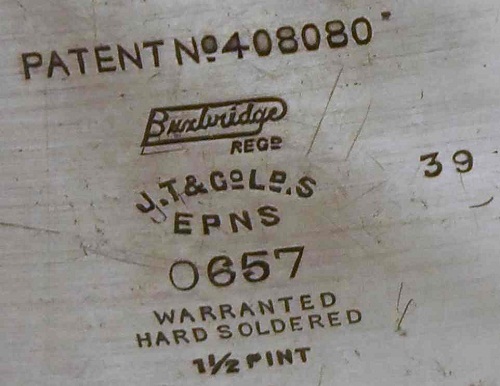So you’ve been handed down Great-Aunt Gertie’s silver service or you found an intriguing silver bowl at an estate sale. Is it valuable? How do you know? If the piece is sterling, it could be worth a great deal. If you turn it over and find a mark that says EPNS or E.P.N.S.,you may be disappointed. EPNS silver will never be as valuable as sterling. Does that mean it doesn’t have any worth? No, it doesn’t. The design or manufacture could make your piece’s value go up, but based on silver content alone, it’s not worth much. Why? Because that beautiful shiny finish is only a thin layer or two of silver plated onto a form that probably consists of a blend of nickel, copper and zinc.
The Quick History of Silver Plating
Although silver is one of the earth’s most abundant metals, it is still expensive and even more problematic, it is weak. Even sterling silver is usually no more than 92.5% pure because it needs added strength from other, harder metals to make it usable. By using stronger metals underneath and coating the surface with a thin layer of sterling or pure silver, items became more affordable and durable. By 1840, George and Henry Elkington were granted the first patents for electroplating and started their business in Birmingham, England. The industry quickly grew to global proportions.
It was discovered that one of the best combinations of metals for the base was 50%-60% copper, 20%-25% nickel and 20%-25% zinc. After that alloy was covered in a layer of silver, it became known as EPNS, an acronym for electroplated nickel silver. It’s sometimes referred to as German silver or nickel silver, and was favored because its pale gold coloring was not as noticeable as other alloys when the layers of silver began wearing away from enthusiastic cleaning.
How to Care for Your EPNS Silver
Whether your EPNS silver has some monetary value or is just worth its weight in gold sentimentally, you’ll want to take care of it so it retains its beauty. Silver plated pieces, like sterling, are vulnerable to tarnish. Tarnish is a type of corrosion that develops from a reaction of silver to sulphur which is found in the earth’s atmosphere and certain foods. Those foods include eggs, fish, olives, salad dressings, peas and other green vegetables. Remove the food from your serving pieces as soon as possible and wash and dry it with a soft cloth immediately to avoid damage.
Always handle EPNS silver with care. The layers of silver coating the piece are thin and can be scratched or eroded away by energetic polishing. Most importantly, though, keep it tarnish free. Even if you don’t use your silver frequently, clean and polish it every three months to prevent airborne tarnish from sulphur in the atmosphere. Wash gently in soapy water, rinse, and dry thoroughly. Then use a modern silver polish that contains jeweler’s rouge or lubricants and oils to protect the piece.
Even though it is less valuable than sterling silver, EPNS silver is still beautiful and a treasure worth collecting.
- 1.
- 2.
- 3.





-

NellieApr.26 23:40
Every weekend i used to pay a quick visit this site, because i want enjoyment, since this
this website conations genuinely fastidious funny stuff too.
fotbollstrøjer
View All Comments /Add Comment